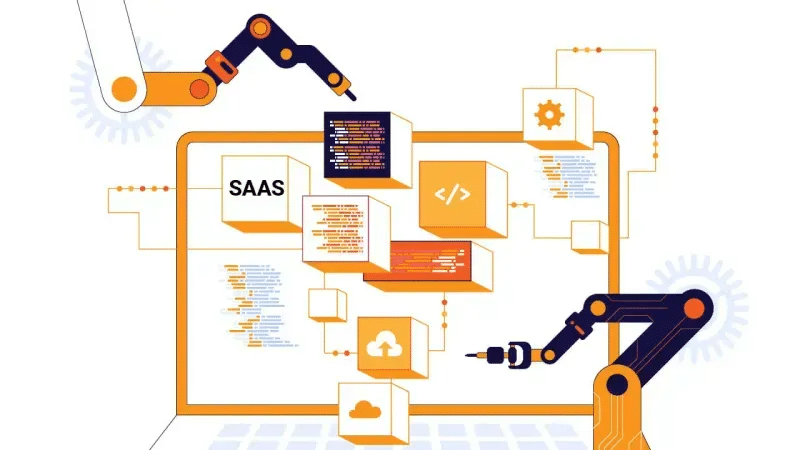In the fast-paced landscape of enterprise technology, the evaluation of Software as a Service (SaaS) tools stands as a pivotal step for organizations seeking to optimize their operational efficiency and strategic capabilities. As businesses navigate the intricate realm of software solutions, the quest for must-have features that align with corporate objectives and IT infrastructure demands becomes increasingly paramount. From scalability and integration to security protocols and user experience, the criteria for successful SaaS adoption hold the key to unlocking enhanced productivity and competitive edge in a digital era where innovation reigns supreme.
Introduction to Evaluating SaaS Tools for Enterprises
As enterprises consider adopting SaaS tools, evaluating the analytics and reporting features is crucial for making informed decisions. Understanding the capabilities of these tools in terms of data analysis and insights can significantly impact operational efficiency and strategic decision-making. By prioritizing robust analytics and reporting functionalities, organizations can harness the full potential of SaaS applications to drive business growth and competitiveness.
Assessing the Analytics and Reporting Features of SaaS Tools
One vital aspect to consider when evaluating SaaS tools for enterprise adoption is the robustness of their analytics and reporting features. Effective analytics are crucial for businesses to gain valuable insights into their operations, customer behavior, and overall performance. SaaS tools that offer advanced analytics capabilities can help organizations make data-driven decisions, optimize strategies, and track key performance indicators.
From sales metrics to marketing campaign performance, having access to comprehensive analytics can enhance efficiency and drive growth. Additionally, robust reporting features enable teams to generate custom reports, visualize data trends, and share insights across the organization. When assessing SaaS tools, prioritizing strong analytics and reporting functionalities, such as those found in saas sales tools, marketing saas solutions, saas monitoring tools, and saas management tools, is essential for maximizing their potential impact on business operations.
Key Features to Look for in SaaS Tools for Effective Enterprise Adoption
When evaluating SaaS tools for enterprise adoption, one crucial aspect to consider is the support and service levels offered by the providers. Robust support mechanisms and responsive service teams are essential for ensuring smooth implementation, troubleshooting, and ongoing maintenance of the SaaS applications within the organization. By prioritizing tools with reliable support structures, enterprises can minimize downtime, optimize user experience, and maximize the value derived from their SaaS investments.

Exploring the Support and Service Levels in SaaS Tools
Amid the landscape of SaaS tools, a paramount consideration for effective enterprise adoption lies in the meticulous evaluation of support and service levels integrated within these platforms. When assessing SaaS tools, organizations must prioritize robust support mechanisms and service offerings to ensure smooth operations and timely issue resolution. Key features to look for include 24/7 customer support, comprehensive training resources, and proactive service monitoring. The table below highlights essential support and service levels that can enhance the overall user experience and maximize the value derived from SaaS tools.
| Support and Service Levels | Description | Benefits |
|---|---|---|
| 24/7 Customer Support | Immediate assistance at any time | Rapid issue resolution and minimal downtime |
| Comprehensive Training Resources | Access to learning materials and guides | Enhanced user proficiency and adoption |
| Proactive Service Monitoring | Continuous system monitoring | Early detection of potential issues for proactive resolution |
How to Choose the Right SaaS Sales Tools for Your Business
To effectively optimize sales processes and enhance customer relationship management, selecting the appropriate SaaS sales tools is crucial for businesses seeking to maximize efficiency and drive revenue growth. When choosing the right SaaS sales tools for your business, several key factors should be considered to ensure the selected tools align with your specific needs and objectives.
Firstly, it is essential to assess your business requirements comprehensively. Understanding the unique aspects of your sales processes, customer interactions, and overall business goals will help identify the specific features and functionalities needed in a SaaS sales tool. Whether it’s lead management, pipeline tracking, or reporting capabilities, tailoring your selection to your business’s requirements is fundamental.
Secondly, evaluating the scalability and flexibility of the SaaS sales tools is vital. As your business grows and evolves, the chosen tools should be able to adapt and accommodate changing needs seamlessly. Scalability ensures that the tools can support increasing data volumes and user numbers without compromising performance.
Additionally, considering the user-friendliness and ease of implementation of the SaaS sales tools is crucial. A user-friendly interface and intuitive design contribute to faster adoption rates among your sales team, leading to quicker realization of benefits and improved productivity.
Lastly, assessing the vendor’s reputation, customer support services, and data security measures is essential. Choosing a reputable vendor with a track record of providing excellent support and robust security protocols ensures a reliable partnership for your business’s sales tool needs. By carefully evaluating these factors, businesses can select the right SaaS sales tools that align with their objectives and drive success in sales operations.
The Importance of Integration Capabilities in SaaS Tools
Effective integration capabilities are essential for SaaS tools to seamlessly connect with existing systems and workflows within an enterprise. This interoperability ensures smooth data flow, enhances operational efficiency, and minimizes disruptions during implementation. Robust integration features not only streamline processes but also contribute to a more cohesive and productive digital environment for businesses.
The Importance of Data Security in SaaS Tools
Ensuring robust data security measures within Software as a Service (SaaS) tools is imperative for safeguarding sensitive information and maintaining compliance standards in enterprise environments. When evaluating SaaS tools for enterprise adoption, data security should be a top priority to mitigate risks and protect valuable assets. Key considerations include:
- Encryption: Implementing end-to-end encryption protocols to secure data both in transit and at rest.
- Access Control: Setting up granular access controls to restrict data access based on user roles and permissions.
- Compliance Certifications: Choosing SaaS providers with industry-standard certifications like ISO 27001 to ensure adherence to stringent security practices.

Security Features Essential for Enterprise SaaS Tools
In the realm of enterprise SaaS tools, robust security features stand as the cornerstone of reliable and trustworthy software solutions. When considering SaaS tools for enterprise adoption, security features are paramount to safeguard sensitive data, ensure compliance with regulations, and protect against cyber threats. Below is a table outlining essential security features that businesses should prioritize when evaluating SaaS tools:
| Security Feature | Description | Importance |
|---|---|---|
| Encryption | Data encryption at rest and in transit to prevent unauthorized access and protect confidentiality. | High |
| Access Control | Role-based access controls, multi-factor authentication, and permission settings to manage user privileges and limit unauthorized access. | Critical |
| Regular Audits | Routine security audits, vulnerability assessments, and penetration testing to identify and address potential security weaknesses proactively. | Essential |
| Data Backup and Recovery | Automated backups, disaster recovery plans, and data redundancy measures to ensure data integrity and availability in case of system failures or breaches. | Crucial |
| Compliance Monitoring | Monitoring tools to ensure compliance with industry regulations (e.g., GDPR, HIPAA) and internal security policies, minimizing legal risks and data breaches. | Mandatory |
Scalability of SaaS Tools: Preparing for Business Growth
In preparing for business growth, ensuring the scalability of SaaS tools is paramount. Customization options play a crucial role in tailoring these tools to meet specific business needs, facilitating seamless integration into existing workflows. Smooth transitions to new SaaS sales tools are essential to maximize efficiency and drive organizational success.
Importance of Customization Options in SaaS Tools
With the increasing demand for scalability in SaaS tools to accommodate business growth, the significance of customization options cannot be overstated. Customization plays a crucial role in tailoring SaaS tools to meet specific organizational needs and enhance overall efficiency. Here are three key reasons why customization options are essential for enterprise adoption:
- Tailored Solutions: Customization allows businesses to adapt SaaS tools to their unique workflows and processes.
- Enhanced User Experience: Personalized features improve user satisfaction and productivity.
- Scalability and Flexibility: Customization options ensure that SaaS tools can grow and evolve alongside the business, adapting to changing requirements seamlessly.
Tips for Smooth Transition to New SaaS Sales Tools
Transitioning to new SaaS sales tools requires meticulous planning and strategic execution to ensure a seamless integration that aligns with business growth objectives. To facilitate a smooth transition, consider the following tips:
| Tips for Transitioning to New SaaS Sales Tools | Description | Benefits |
|---|---|---|
| Conduct thorough training sessions for employees | Ensure all users are proficient in using the new tools | Increased productivity and efficiency |
| Establish clear communication channels for feedback | Encourage user engagement and gather insights for optimization | Improved tool adoption rates |
| Create a phased implementation plan | Gradual rollout to minimize disruptions | Smooth transition and reduced resistance |
| Regularly monitor performance metrics | Track usage, performance, and user satisfaction | Identify areas for improvement and optimization |
User Experience: A Critical Factor in SaaS Tool Selection
User experience plays a pivotal role in the successful adoption of SaaS tools by enterprises. The design of the user interface significantly impacts the usability and effectiveness of these tools within organizations. A seamless and intuitive user experience can enhance productivity, user engagement, and overall satisfaction with the SaaS applications being utilized.
The Impact of User Interface Design on SaaS Tool Usability
Effective user interface design plays a pivotal role in determining the usability and overall success of SaaS tools within enterprise environments. A well-crafted user interface can significantly impact user satisfaction, productivity, and adoption rates. To achieve optimal usability, SaaS tools should prioritize the following:
- Intuitive Navigation: Clear and logical menu structures enhance user experience.
- Consistent Design Elements: Uniformity in layout, colors, and fonts promotes visual coherence.
- Customization Options: Providing users with the ability to personalize interfaces can improve efficiency and user engagement.
Cost-Effectiveness of Marketing SaaS Solutions for Enterprises
Amid the growing demand for enhanced marketing capabilities in enterprises, the cost-effectiveness of adopting Marketing SaaS solutions has become a pivotal consideration. Marketing SaaS solutions offer a range of benefits, including automation, analytics, and scalability, making them attractive options for businesses looking to streamline their marketing efforts. However, it is crucial for enterprises to assess the cost-effectiveness of these solutions to ensure they align with budgetary constraints while delivering the desired outcomes.
To evaluate the cost-effectiveness of Marketing SaaS solutions, enterprises should consider various factors, as outlined in the table below:
| Factors to Consider | Description | Impact |
|---|---|---|
| Initial Setup Costs | Expenses related to onboarding, customization, and training | Can significantly impact upfront investment |
| Subscription Fees | Recurring costs for accessing the SaaS platform | Should be weighed against benefits provided |
| Scalability Options | Ability to adjust services based on business growth and needs | Influences long-term cost efficiency |
| Integration Capabilities | Seamless integration with existing systems and third-party applications | Affects overall efficiency and ROI |
The Role of SaaS Monitoring Tools in Maintaining System Health
When it comes to maintaining system health in enterprise environments, the role of SaaS monitoring tools cannot be overstated. These tools play a crucial part in ensuring compliance with regulatory standards and industry requirements. By proactively monitoring system performance and security, businesses can mitigate risks and optimize the overall health of their SaaS applications.

Compliance and Regulatory Considerations in SaaS Tools
When it comes to SaaS tools, compliance and regulatory considerations are paramount. Selecting the right SaaS monitoring tools is crucial for maintaining system health and ensuring adherence to industry standards. These tools play a vital role in proactively identifying and addressing issues to keep operations running smoothly.
Criteria for Selecting SaaS Monitoring Tools
Selecting SaaS monitoring tools for enterprise use requires meticulous consideration of key criteria to ensure system health and compliance with regulatory standards.
- Scalability: Ability to handle increasing data volumes and monitoring requirements.
- Real-time Alerts: Immediate notification of potential issues or breaches.
- Customizable Dashboards: Tailored views to track specific metrics and KPIs effectively.
Advancements in SaaS Management Tools for Enhanced Productivity
Enhancing productivity in enterprise environments requires a focus on the mobile readiness of marketing SaaS solutions. Ensuring that these tools can adapt to the evolving technological landscape is crucial for future-proofing businesses. Scalable SaaS management tools play a vital role in optimizing workflows and driving efficiency in organizations.
Evaluating the Mobile Readiness of Marketing SaaS Solutions
With the increasing reliance on mobile technology in today’s business landscape, evaluating the mobile readiness of marketing SaaS solutions has become a critical aspect for enhancing productivity through advancements in SaaS management tools.
- Responsive Design: Ensuring SaaS solutions can adapt seamlessly to various mobile devices.
- Offline Access: Allowing users to work offline and sync data when back online.
- Mobile App Integration: Integrating with other mobile apps for a more streamlined user experience.
Future-Proofing Your Business with Scalable SaaS Tools
In the dynamic landscape of enterprise technology, the ability to optimize costs and enhance productivity through effective SaaS tool management is crucial. Embracing advancements in AI and Machine Learning within SaaS tools can empower businesses to scale efficiently and stay ahead in an ever-evolving market. By leveraging these technologies, organizations can future-proof their operations and drive sustained growth in a competitive environment.
Optimizing Costs with Effective SaaS Tool Management
To achieve optimal cost-efficiency and productivity in enterprise operations, the strategic management of Software as a Service (SaaS) tools is crucial in today’s competitive business environment.
- Implement automated license tracking to avoid unnecessary costs
- Utilize usage analytics for informed decision-making on tool subscriptions
- Regularly audit SaaS tool usage to eliminate underutilized resources

Leveraging AI and Machine Learning in SaaS Tools
Leveraging advancements in AI and Machine Learning within SaaS tools is essential for enhancing productivity and future-proofing enterprises in today’s dynamic business landscape. These technologies enable automation of tasks, personalized user experiences, predictive analytics for informed decision-making, and enhanced security measures. By integrating AI and Machine Learning capabilities, SaaS tools can streamline operations, drive innovation, and provide a competitive edge in the market.
Comprehensive Software Development Solutions
Unlock the potential of digital transformation with our bespoke software development services, engineered to foster innovation, maximize efficiency, and catalyze business growth.
Conclusion
In conclusion, the evaluation of SaaS tools for enterprise adoption is a critical process that requires careful consideration of key features such as integration capabilities, security protocols, user experience, cost-effectiveness, and system monitoring tools. By prioritizing these essential attributes, businesses can effectively streamline operations, enhance productivity, and maintain system health. It is imperative for organizations to strategically select SaaS tools that align with their goals and contribute to sustained scalability in the evolving digital landscape.
How Can Enterprises Ensure That Their Chosen Saas Tools Are Compliant With Industry Regulations and Data Protection Laws?
Enterprises must ensure compliance with industry regulations and data protection laws by thoroughly examining SaaS tools’ certifications, encryption capabilities, data handling practices, and auditing features. Transparency in vendor policies and adherence to legal requirements are key factors in selection.
What Are Some Key Factors to Consider When Evaluating the Vendor’s Customer Support and Service Level Agreements for Saas Tools?
When evaluating SaaS tools, key factors in assessing the vendor’s customer support and service level agreements include responsiveness, availability, expertise, and adherence to SLA terms. Strong support ensures smooth integration, minimal downtime, and prompt issue resolution, enhancing overall user experience and operational efficiency.
How Can Businesses Assess the Performance and Reliability of Saas Tools Before Making a Final Decision on Adoption?
Businesses can assess SaaS tools’ performance and reliability through rigorous testing, evaluating system uptime, response times, and scalability. Conducting pilot projects, seeking references, and examining service level agreements can provide valuable insights to inform adoption decisions effectively.
What Strategies Can Enterprises Implement to Effectively Train Employees on Using New Saas Tools and Ensure Successful Adoption?
Enterprises can ensure successful adoption of new SaaS tools by implementing comprehensive training programs tailored to employees’ needs, providing hands-on experience, offering continuous support, and fostering a culture of learning and adaptation to drive proficiency and maximize tool utilization.


